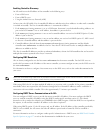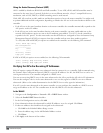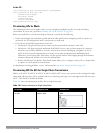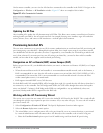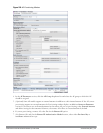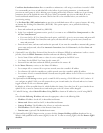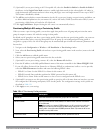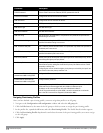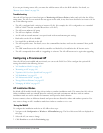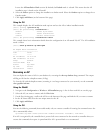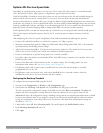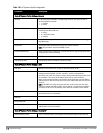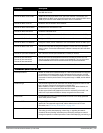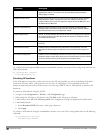
13. (Optional) If you are provisioning an 802.11n-capable AP, select the Enable for Radio-0 or Enable for Radio-1
checkboxes in the Single-Chain Mode section to enable single-chain mode for the selected radio. AP radios in
single-chain mode will transmit and receive data using only legacy rates and single-stream HT rates up to MCS 7.
This feature is disabled by default.
14. The AP list section displays current information for the AP you are provisioning or reprovisioning, and allows you
to define additional parameters for your remote AP, such as AP Name, SNMP System Location and (if you are
provisioning a Mesh Point or Portal) the AP’s Mesh role.
15. Click Apply and Reboot. (Reprovisioning the AP causes it to automatically reboot).
Provisioning Multiple APs using a Provisioning Profile
When you create a provisioning profile, you can then apply that profile to an AP group and provision that entire
group of campus or remote APs with the settings in that profile.
By default, an AP group does not have a provisioning profile. Make sure that any provisioning profiles you create are
complete and accurate before you assign that profile to an AP group. If a misconfigured provisioning profile is
assigned to a group of APs, the APs in that group may be automatically provisioned with erroneous parameters and
become lost.
1. Navigate to the Configuration > Wireless > AP Installation > Provisioning window.
2. Next, select the Provisioning Profile tab and enter a provisioning profile name in the text box (next to the Add
button).
3. Click the Add button to add the profile name.
4. Select your new provisioning profile name from the list at the left.
5. (Optional) If you are provisioning a remote AP, select the Remote-AP checkbox.
6. Enter the IP address or the fully qualified domain name of the master controller in the Master IP/FQDN field.
7. If your AP will use Point-to-Point Protocol over Ethernet (PPPoE) to authenticate itself to a service provider,
select the PPPoE Parameters checkbox and enter the following PPPoE values:
l PPPoE User Name: Set the PPPoE User Name for this remote AP.
l PPPoE Password: Enter and then confirm the PPPoE password for this remote AP.
l PPPoE Service Name: Either an ISP name or a class of service configured on the PPPoE server.
8. (Optional) If you want to use this provisioning profile to provision APs with more than one interface, you must
also configure the USB settings and priority levels for this profile. The configuration settings in this profile are
described in Table 119.
9. Click Apply to save your settings.
Parameter Description
Remote-AP Select this checkbox to provision the group of APs as remote APs.
Master IP/FQDN The fully qualified domain name (FQDN) or IP address of the controller to which the
AP is associated.
NOTE: If you configure a master IP/FQDN setting in an AP’s provisioning profile, this
setting will override any LMS and backup LMS settings configured in an AP’s AP
system-profile. Leave the master IP/FQDN parameter blank if you want the AP to use
the LMS or backup LMS values.
PPPOE User Name : Point-to-Point Protocol over Ethernet (PPPoE) password for the AP.
Table 119:
AP Provisioning Profile parameters
DellPowerConnectW-SeriesArubaOS6.2 | User Guide AccessPoints(APs) | 413



